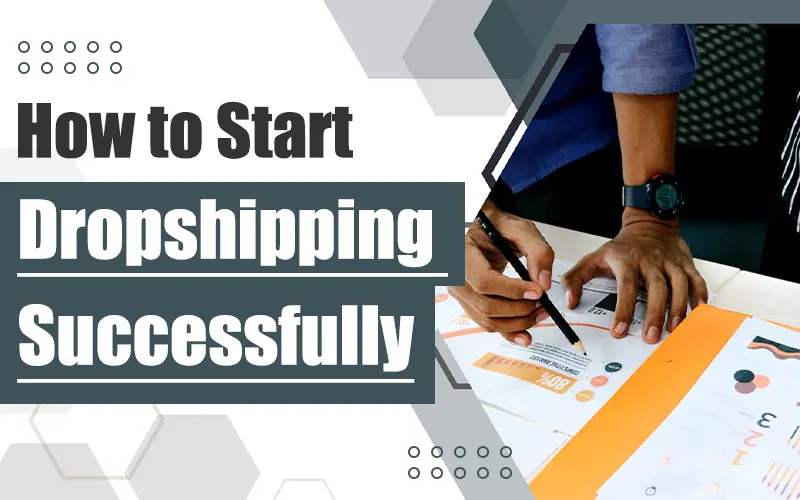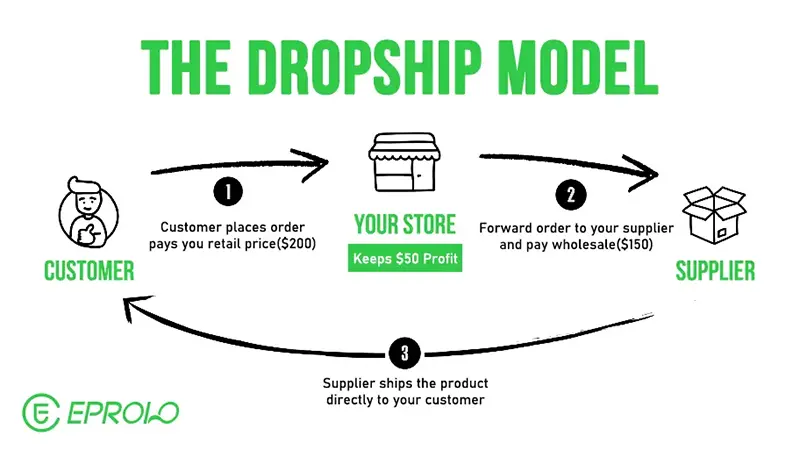Dropshipping transforms the traditional retail supply chain, introducing a streamlined approach to e-commerce. At its core, the process begins when a customer places an order on your online store. Instead of stocking and managing inventory yourself, the product is directly shipped to the customer from a third-party supplier. Dropshipping epitomizes efficiency in the world of retail.
Wondering how to start a dropshipping business?
In this blog, we will delve into the intricacies of how dropshipping operates, providing you with a comprehensive understanding of the steps involved in starting your dropshipping business.

Page overview:
Understanding Dropshipping: What You Need to Know
Benefits of Dropshipping Over Traditional Methods
How to Start a Dropshipping Business
Step 1 – Research and Planning
Step 2 – Choosing Your Dropshipping Platform
Step 4 – Finding Reliable Suppliers
Step 5 – Building Your Online Store
Step 6 – Implementing Marketing Strategies
Understanding Dropshipping: What You Need to Know
Understanding dropshipping involves recognizing the pivotal roles of the key players in this business model:
- Retailer: You, the entrepreneur, operate the online store, curate products, and handle customer interactions, marketing, and sales.
- Supplier: The supplier is the backbone of dropshipping and is responsible for warehousing, inventory management, and order fulfillment. They dispatch products directly to customers on behalf of the retailer.
- Customer: The end consumer places orders on the retailer’s website, expecting timely delivery of the chosen products.

Benefits of Dropshipping Over Traditional Methods
As with any business model, dropshipping comes with its own pros and cons. Understanding these nuances is crucial for making informed decisions as you navigate the realm of e-commerce.
Advantages:
- Low Financial Risk: Unlike traditional retail models, dropshipping minimizes the financial risk as you don’t need to invest in bulk inventory upfront.
- Reduced Overhead Costs: Operating without the need for storage space or warehouse management allows for significantly lower overhead costs, contributing to increased profit margins.
- Broader Product Range: Dropshipping allows you to offer a vast array of products without the constraints of physical inventory, providing flexibility and adaptability to changing market demands.
- Scalability: The model is inherently scalable as there is no limit to the number of products you can offer, and you can expand your business without the burden of managing increased inventory.
Disadvantages:
- Limited Control Over Inventory: Relying on third-party suppliers means less control over inventory levels, potentially leading to issues like stockouts or shipping delays.
- Thinner Profit Margins: While the financial risk is lower, profit margins may also be slim due to the cost of outsourcing order fulfillment.
How to Start a Dropshipping Business
Ready to launch your dropshipping business? Here’s a detailed guide on how to start dropshipping like a pro.
Step 1 - Research and Planning
Choosing the right niche is the cornerstone of a successful dropshipping venture. The niche you select defines your target market and influences your product offerings. A well-defined niche not only sets you apart from the competition but also helps you cater to a specific audience with unique needs and preferences. In this phase, you lay the groundwork for a focused and profitable business.
Tools and Strategies for Niche Research and Market Analysis
- Google Trends: Explore trending topics and identify seasonality within potential niches using Google Trends to understand long-term viability.
- Keyword Research Tools: Utilize tools like Google Keyword Planner or SEMrush to identify high-volume keywords related to potential niches, gauging online interest and demand.
- Social Media Platforms: Monitor discussions, groups, and pages on platforms like Facebook, Instagram, and Reddit to identify popular topics and emerging trends within your target niches.
- Competitor Analysis: Tools like Ahrefs or SEMrush can help analyze competitor websites, identifying their strengths, weaknesses, and unique selling propositions.
- Create Buyer Personas: Develop detailed buyer personas to understand the demographics, interests, and pain points of your potential customers.
- Surveys and Feedback: Conduct surveys or seek feedback on social media platforms to gather insights directly from your target audience.
Step 2 - Choosing Your Dropshipping Platform
Selecting the right dropshipping platform is pivotal to the success of your online store. Here are some factors to consider when choosing a dropshipping platform.
- Ease of Use: Consider your technical proficiency and choose a platform that aligns with your comfort level in terms of setup, management, and customization.
- Costs: Evaluate the pricing structure of each platform, including transaction fees, subscription plans, and any additional costs associated with third-party apps or integrations.
- Scalability: Ensure the platform can grow with your business. Look for features and plans that accommodate increasing product lines, traffic, and sales.
- Integration with Dropshipping Apps: Check compatibility with popular dropshipping apps like Oberlo or AliExpress Dropshipping, ensuring smooth order fulfillment.
Step 3 - Domain and Branding
Choose a domain name that aligns with your brand, communicates your niche, and is easy to remember. Remember, a professional and relevant domain name builds trust with customers and enhances your brand’s credibility – the cornerstone of a successful dropshipping business. Here are some tips for creating a brand identity:
- Logo Design: Craft a distinctive and visually appealing logo that represents your brand values and resonates with your target audience.
- Color Scheme and Typography: Establish a consistent color palette and typography to create a cohesive and recognizable brand image.
- Brand Messaging: Develop clear and compelling brand messaging that communicates your unique selling propositions and resonates with your target market.
Step 4 - Finding Reliable Suppliers
One of the critical elements of a successful dropshipping business is establishing solid partnerships with reliable suppliers. In this step, we’ll explore the strategies and considerations involved in finding suppliers who can consistently meet your business needs.
- Industry Research: Explore industry-specific forums, trade shows, and communities to identify reputable suppliers within your niche. Read reviews and testimonials from other businesses that have worked with potential suppliers.
- Direct Communication: Reach out directly to suppliers to discuss their capabilities, product range, and fulfillment processes. Inquire about their experience with dropshipping and their willingness to collaborate with small to medium-sized businesses.
- Sample Orders: Request product samples to assess quality firsthand before committing to a partnership. Evaluate packaging and shipping times to ensure they meet your standards.
- Product Range: Ensure the supplier offers a diverse range of products within your niche to provide variety for your customers. Assess their ability to adapt and expand their product catalog based on market trend.
- Pricing and Terms: Negotiate pricing terms, including bulk discounts or volume-based incentives. Clearly define terms and conditions related to order fulfillment, returns, and refunds. Draft a comprehensive contract outlining the responsibilities and expectations of both parties.
- Diversifying Suppliers for Risk Mitigation: Consider working with multiple suppliers to diversify your product sources and reduce dependency on a single partner.

Step 5 - Building Your Online Store
A seamless design, coupled with compelling product listings, sets the stage for a positive user experience and increased conversions. Prioritize intuitive navigation to ensure visitors can easily explore your product categories and find what they’re looking for. Here are some tips for choosing a responsive and visually appealing design and writing compelling product descriptions:
- High-Quality Imagery: Use high-resolution images that showcase your products from various angles, providing a realistic and appealing representation.
- Minimized Load Times: Optimize your website’s performance by compressing images and utilizing efficient coding practices to minimize load times.
- Storytelling: Incorporate storytelling elements to create an emotional connection with your audience, explaining the origin or inspiration behind your products.
- Features and Specifications: Provide detailed information about product features, specifications, and dimensions to help customers make informed decisions.
- Optimizing Product Listings for Search Engines: Identify relevant keywords for each product and incorporate them naturally into your product titles, descriptions, and meta tags. Avoid duplicate content by crafting unique product descriptions for each item, enhancing search engine optimization (SEO), and standing out from competitors.
Step 6 - Implementing Marketing Strategies

Implementing effective marketing strategies is crucial for promoting a business and reaching a wider audience. Here’s a breakdown.
- Leveraging Platforms for Promotion: Identify the most relevant social media platforms for your business. Consider factors such as your target audience, industry, and the nature of your products or services. Consider paid advertising features on social media platforms to extend your reach to a broader audience.
- Engaging with the Community: Respond promptly to comments, messages, and mentions on social media. Cultivate a community by prompting questions, running polls, and fostering engaging discussions. Broaden your outreach by partnering with influencers and collaborating with other businesses.
Step 7 - Managing Operations
The next step involves managing the operational aspects of your business, particularly focusing on order fulfillment and customer service. Effective operations management is essential for customer satisfaction and the overall success of your business. Here’s how you can focus on both:
Order Fulfillment
- Effective Inventory Management: Employ a resilient inventory management system to meticulously monitor stock levels. Initiate automated alerts for low-stock items, mitigating the risk of depletion in high-demand products.
- Efficient Order Processing: Integrate a dependable order tracking system, allowing customers to monitor their order status seamlessly. Ensure transparent communication by promptly sharing order confirmations, shipping, and delivery details with customers.
- Streamlined Returns and Exchanges: Establish a transparent and customer-centric return and exchange policy. Simplify the returns process to reduce customer effort. Additionally, leverage data from returned products to discern patterns and enhance overall product quality.
Customer Service
- Training and Empowering Staff: Train customer service representatives on product knowledge and effective communication. Empower staff to resolve common issues independently, reducing the need for escalations.
- Feedback Collection: Implement customer feedback mechanisms to understand their experiences. Regularly analyze feedback to identify areas for improvement and address any issues.
- Customer Education: Create resources (FAQs, tutorials, guides) to help customers use products effectively. Proactively educate customers on order status, upcoming promotions, and relevant information.
Step 8 - Analyzing and Adapting

By consistently analyzing performance metrics and adapting strategies based on the insights gained, your business can remain agile, competitive, and responsive to changing market dynamics. This iterative process ensures continuous improvement and long-term success. Here are key components to consider:
- Financial Analysis: Regularly review financial statements, including income statements, balance sheets, and cash flow statements. Identify key financial metrics such as revenue, expenses, and profit margins.
- Sales and Marketing Analytics: Analyze the effectiveness of marketing campaigns through key performance indicators (KPIs) such as conversion rates, click-through rates, and return on investment (ROI). Evaluate sales performance, considering factors like customer acquisition costs and customer lifetime value.
- Surveys and Feedback: Conduct customer surveys to gather feedback on products, services, and overall experience. Analyze customer reviews and ratings on various platforms.
- Market Analysis: Stay informed about industry trends, emerging technologies, and changes in consumer behavior. Analyze market research data to identify opportunities and threats in the external environment.
- Adopting New Technologies: Stay abreast of technological advancements relevant to your industry. Assess how new technologies can improve efficiency, customer experience, and overall business operations.
- Risk Management: Evaluate potential risks and challenges that may impact your business. Develop contingency plans to mitigate risks and respond effectively to unexpected events.
Conclusion
Now that you understand how to dropship, you know the roadmap to establishing a prosperous business requires meticulous planning, strategic implementation, and a readiness to adapt. From the initial stages of conceptualization and market exploration to the execution of impactful marketing strategies and effective operational management, every phase plays a pivotal role in shaping the overall success of the enterprise.
As we navigate the complex terrain of entrepreneurship, the significance of analyzing performance and embracing change becomes evident. Prioritizing customer satisfaction, as demonstrated through streamlined order processing, responsive customer service, and user-friendly return policies, not only fosters loyalty but also forges a positive brand identity.
As entrepreneurs, let’s carry forward the lessons assimilated, recognizing that each challenge is an opportunity, and every adaptation propels us closer to enduring success. The business environment may undergo transformations, but our unwavering commitment to excellence, customer satisfaction, and continuous enhancement will stand as guiding principles, propelling us toward a future marked by prosperity and longevity.
FAQs
1. Do I need to hold inventory in dropshipping?
No, one of the main advantages of dropshipping is that you don’t need to hold inventory. The products are shipped directly from the supplier to the customer.
2. How do I find dropshipping suppliers?
You can find dropshipping suppliers through online marketplaces, industry directories, or by reaching out to manufacturers. Ensure you choose reputable suppliers with a history of reliability.
3. What platform should I use for my dropshipping store?
Popular platforms for dropshipping include Shopify, WooCommerce, and BigCommerce. Choose a platform that aligns with your business needs and budget.
4. How do I handle customer service in dropshipping?
Customer service is vital. Communicate effectively, provide timely responses, and work closely with your suppliers to resolve any issues promptly.
5. What are the risks of dropshipping?
Risks may include shipping delays, product quality issues, or inventory problems. Choose reliable suppliers and have contingency plans in place.







